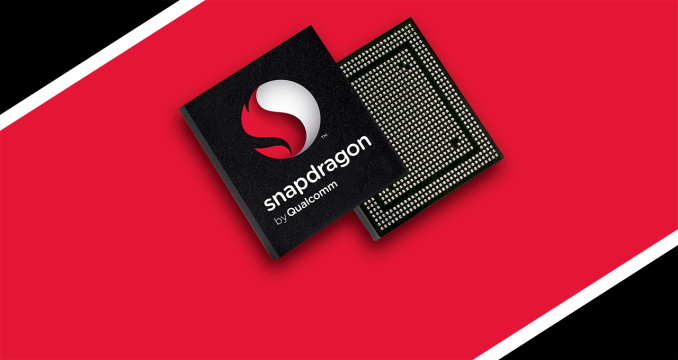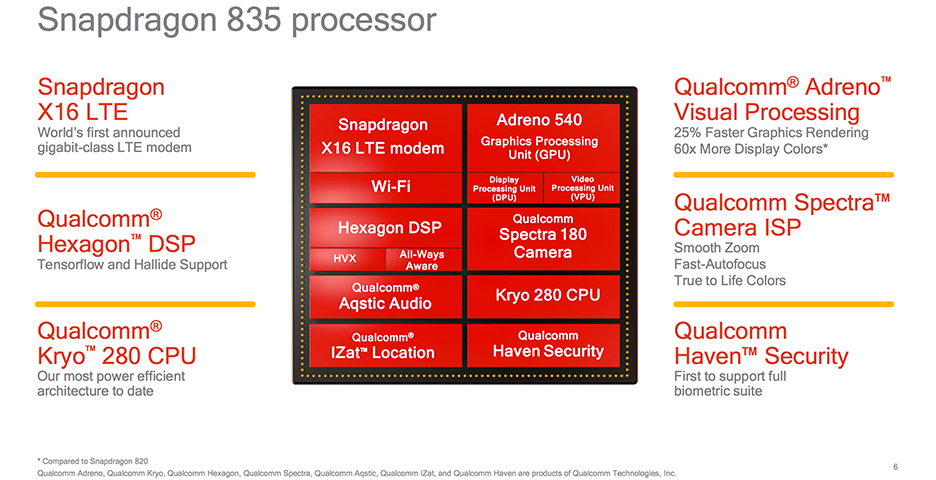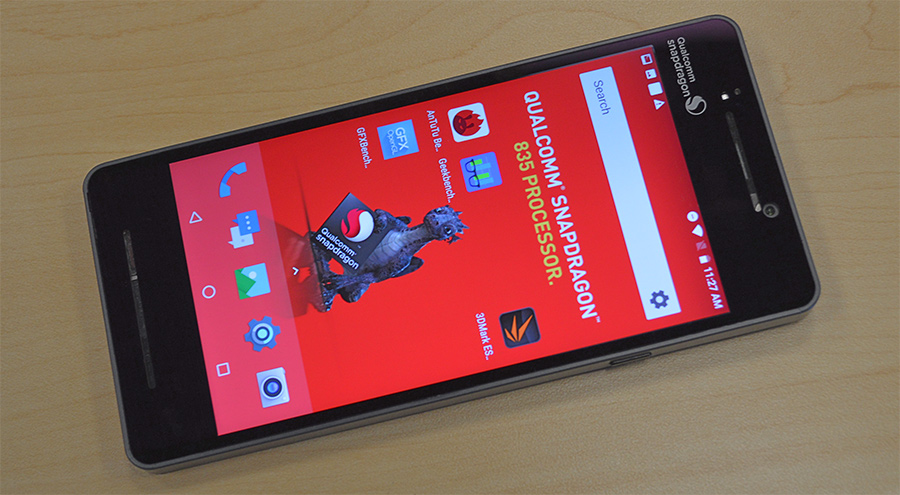The Qualcomm Snapdragon 835 Performance Preview
by Matt Humrick & Ryan Smith on March 22, 2017 4:30 AM EST- Posted in
- Smartphones
- Snapdragon
- Qualcomm
- Mobile
- SoCs
- Snapdragon 835
- Kryo

The Snapdragon 820 SoC was a significant milestone on Qualcomm’s roadmap. It was a solid improvement over the 808/810, delivering higher performance and efficiency, and became a commercial success, finding its way into the majority of flagship phones last year. More importantly, it heralded Qualcomm’s vision for mobile devices: heterogeneous computing. This meant new hardware—a much improved Hexagon 680 DSP that added single instruction, multiple data (SIMD) Hexagon Vector Extensions (HVX); Qualcomm’s first fully-custom 64-bit CPU core, Kryo, which focused on improving floating-point IPC; and an updated Adreno GPU with strong ALU performance—for enabling new software technologies and user experiences—artificial intelligence for smarter personal assistants, machine learning for object recognition, computational photography for better image and video quality, and new AR/VR experiences.
Snapdragon 835—now a part of Qualcomm’s Snapdragon Mobile Platform that includes all of the company’s mobile hardware and software—is an evolutionary product that builds on this vision. The greater than 3 billion transistor SoC is the first to use Samsung’s 10nm "10LPE" FinFET process, which reduces overall package size by 35% relative to Snapdragon 820. The new SoC’s CPU transplant and X16 LTE modem, which tops out at 1Gbps (Category 16) on the downlink, are the biggest changes, but most of the other blocks within the SoC have received at least minor updates too. For detailed information about all the changes and new features, you can read our Snapdragon 835 launch article.
| Qualcomm Snapdragon SoCs: Three Generations | |||
| SoC | Snapdragon 835 (MSM8998) |
Snapdragon 820 / 821 (MSM8996 / MSM8996 Pro) |
Snapdragon 810 (MSM8994) |
| CPU | 4x Kryo 280 Performance @ 2.45GHz 4x Kryo 280 Efficiency @ 1.90GHz |
2x Kryo @ 2.15GHz / 2.34GHz 2x Kryo @ 1.59GHz / 2.19GHz |
4x Cortex-A57 @ 2.00GHz 4x Cortex-A53 @ 1.50GHz |
| GPU | Adreno 540 @ 710MHz ? | Adreno 530 @ 624MHz / 653MHz | Adreno 430 @ 630MHz |
| Memory | 2x 32-bit @ 1866MHz LPDDR4x 29.9GB/s |
2x 32-bit @ 1866MHz LPDDR4 29.9GB/s |
2x 32-bit @ 1600MHz LPDDR4 25.6GB/s |
| ISP/Camera | Dual 14-bit Spectra 180 ISP 1x 32MP or 2x 16MP |
Dual 14-bit Spectra ISP 1x 25MP or 2x 13MP |
Dual 14-bit ISP 1x 21MP |
| Encode/Decode | 2160p30 (2160p60 decode), 1080p120 H.264 & H.265 |
2160p30 (2160p60 decode), 1080p120 H.264 & H.265 |
2160p30 (2160p60 decode), 1080p120 H.264 & H.265 |
| Integrated Modem | Snapdragon X16 LTE (Category 16/13) DL = 1000Mbps 3x20MHz CA, 256-QAM UL = 150Mbps 2x20MHz CA, 64-QAM |
Snapdragon X12 LTE (Category 12/13) DL = 600Mbps 3x20MHz CA, 256-QAM UL = 150Mbps 2x20MHz CA, 64-QAM |
Snapdragon X10 LTE (Category 9) DL = 450Mbps 3x20MHz CA, 64-QAM UL = 50Mbps 1x20MHz CA, 16-QAM |
| Mfc. Process | 10nm LPE | 14nm LPP | 20nm SoC |
In what has become an annual tradition going all the way back to Snapdragon 800, Qualcomm invited the media to its headquarters in San Diego for some feature demonstrations and limited testing using the company's Mobile Development Platform (MDP) devices. These are fully functional tablets or smartphones in a slightly oversized, utilitarian chassis used for hardware testing and software development. The MDP for Snapdragon 810 took the form of a tablet, while Snapdragon 820 came inside a large smartphone with a 6.2-inch display. This downsizing trend continues for Snapdragon 835, whose MDP/S is a smartphone with 6GB of RAM, a 5.5-inch 2560x1440 display, and a small 2850 mAh battery. The use of a smaller chassis is encouraging, because it has less mass and surface area to absorb and dissipate heat. This suggests a lower TDP for the 835, but we'll need to measure power consumption to be sure.
Because we only had a limited time for testing, we focused on running some basic CPU, GPU, and memory performance tests. Keep in mind that we were testing prototype hardware running pre-production software that resulted in a few hiccups. The condensed testing period also forced us to stray slightly from our usual testing methodology. Therefore, these numbers should be viewed as preliminary and could change by the time retail units begin shipping.












128 Comments
View All Comments
gigathlete - Wednesday, March 22, 2017 - link
There is individual load times per app at the end of the video did you finish the whole thing?techconc - Monday, April 3, 2017 - link
@TadzioPazurThe "test" isn't broken. Rather, it's a measure of NAND storage performance rather than of the SoC.
grayson_carr - Saturday, March 25, 2017 - link
Kind of an unfair test. On Android, they completely disabled animations, so apps appear as soon as they are loaded, but on iOS there is no option for that. They claim they disabled animations on iOS, but they actually just enabled the reduce motion feature, which doesn't disable animations, but just changes them from a zoom to a fade animation.TadzioPazur - Wednesday, March 22, 2017 - link
No. You seem to miss the point, as apperent from your post, comparing a SoC (835) to a complete product (6 month old phone). This is an important distinction, as pointed out by the editors: commanding victories in JS department come largely (if not solely) from the JS engine used by the browser.Let's nitpick the iPhone7s standings:
CPU tests: 8 x N/A, 3 x 1st (all JavaScript)
GPU tests: joint 1st, 2nd, N/A, N/A, 6, 2, 12, 1, N/A N/A, joint 1st
So iPhone is present on 10 graphs, being non-joint 1st ("trouncing everything else") on 4 of them. Hardly "most of graphs".
lefty2 - Wednesday, March 22, 2017 - link
iPhone 7 scores 3306 in geekbench 4 single core, while the fastest android Samsung Galaxy S7 scores 1789 (https://browser.primatelabs.com/ios-benchmarks). So, yankeeDDL is correct, Apple's A10 trounces everything else (in single thread, which is the most important in a smartphone).joms_us - Wednesday, March 22, 2017 - link
Except that Geekbench is worthless and does not represent real-world performance.melgross - Wednesday, March 22, 2017 - link
No worse than any of the other tests such as PCMark. The importance is that all of these devices will perform about the same in real world use as they do in these tests.milli - Wednesday, March 22, 2017 - link
Geekbench is synthetic. PCMark tests with actual apps.joms_us - Thursday, March 23, 2017 - link
Yep, PCMark is the best out there. It is doing real tasks, you can see what it is doing not just some random progress bar or percent like Geekbench LoL.arayoflight - Wednesday, March 22, 2017 - link
Geekbench scores shouldn't be compared across platforms since language used as well as the compiler can make a lot of difference.My old lenovo y510p scored 3600 single core on geekbench single core in Windows. When I booted in Ubuntu, the score jumped to 4400. Multi core scores were 11000 and 12500 respectively.
As evident, it's pretty pointless to compare it. Not to mention that almost all the tests can be done in L2 cache if it's sufficiently big. That's a really unrealistic test.